Menus
- Roadster with Sugomi sauce or decarenated sports car
- Discovery
- In the saddle
- Contact
- In the city
- On the highway
- On departmental
- Comfort / Duo
- Braking
- Consumption
- Convenient
- Conclusion
- Kawasaki Z400 video test
Roadster with Sugomi sauce or decarenated sports car
A2 licenses have the choice between large bridles, sometimes very badly bridled, and smaller ones, often lacking a trunk, especially in 400 cm3. This was also the case before at Kawasaki with the Z300 which returns with an additional 100 cm3 in its Z400 version, a roadster version of the sporty Ninja 400 that we had already tested last year.. So what does the Z400 give on a daily basis ?
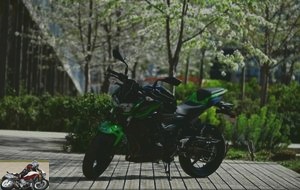 Kawasaki Z400 under the cherry blossoms
Kawasaki Z400 under the cherry blossoms
Discovery
The Z400 is again a version of the Sugomi style so dear to Kawasaki. And in these categories of motorcycles, the look will be almost as important as the engine, the engine is not the ultimate weapon but rather a story of compromise. We could almost see a certain affiliation with a certain Z1000 from the very beginnings. For the rest, we find a Ninja 400 decarenated to the end of the rear end. Indeed, the Ninja 400 and the Z400, it’s a little green cap and green cap, if we forget the fairing and the speedometer. For the rest, cycle part, chassis and engine are identical. There is little that the position which changes noticeably for the pilot, with the choice between the handlebars bracelets of the Ninja and the wide handlebars of the Z. But when you put the two motorcycles side by side, the Ninja gives the impression of being bigger, even if only one kilo separates the two models. So, the choice between the Ninja and the Z, a simple matter of taste and look? Not only.
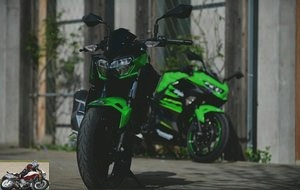 Kawasaki Z400 headlight
Kawasaki Z400 headlight
Kawasaki Z400 and Ninja 400 share the same engine with this in-line twin of exactly 399 cc, now delivering 45 hp at 10,000 rpm and 38 Nm at 8,000 rpm and therefore 7 more horsepower and 6 kilos less than the 300 ! Here, a weight / power ratio that has nothing to do with the old model.
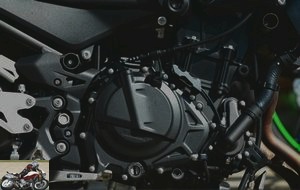 Parallel twin-cylinder, 4-stroke, liquid-cooled, distribution by double overhead camshaft, four valves per cylinder
Parallel twin-cylinder, 4-stroke, liquid-cooled, distribution by double overhead camshaft, four valves per cylinder
In the saddle
With a saddle at 785 mm, small riders will be comfortable, aided by a featherweight of 167 kilos, all full. The full facts really change something, because the first impression on the handlebars is to have a super light machine. A lightness that can also be appreciated during handling when stationary, just to push the machine into the garage.
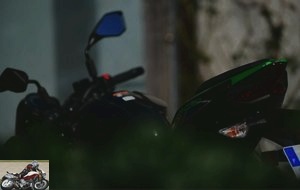 Rear light Kawasaki Z400
Rear light Kawasaki Z400
The position is natural, even if the bust tilts noticeably forward. At least we are not resting on the wrists like the Ninja. But especially the curve of the tank is ideal helped by the smoothness of the saddle. Result, the thighs perfectly enclose the tank for a really very pleasant overall position, among one of the most pleasant positions of current production. It seems excessive, but no, we do really well with the machine and nothing gets in the way.
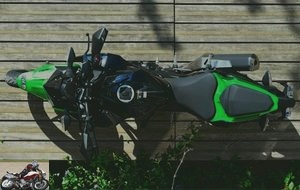 Top view
Top view
Under the eyes, we find a counter identical to that of the 650, but not to that of the Ninja 400. It is specific, not really beautiful, especially with these 4 screws which would have deserved caps. But it is complete, including with the gear engaged indicator, the fuel gauge and the clock at the same time. For the rest, everything is perfectly readable, including under the sun.
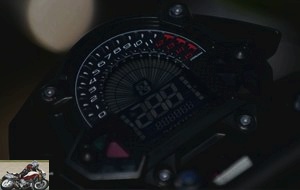 Speedometer with gear engaged
Speedometer with gear engaged
The mirrors are not extraordinary, but they return a useful partial picture.
Contact
The small twin is snorting in a light growl, almost serious. First soft and the machine quietly winds up. The first remarkable thing is the smoothness of the gearbox. We touch the box and the reports happen by themselves. The clutch is flexible, easy and we forget the gearbox, especially since the engine is particularly flexible, even accepting to start again from 30 km / h on idle..
 Of style
Of style
In the city
We could stay in town on the first report, this one cheerfully accepting 60 km / h, without even entering the red zone. On the other hand, we feel some vibrations around 5,000 rev / m which encourage passing the second, or even the third. In fact, you can even drive quietly in the last gear, without any jerk, as long as you are at least 40 km / h. You can drive at 30 km / h on the last report, but at 2,000 rpm, it still hits noticeably and you are not very far from the setting with your finger on the clutch handle.
The engine is extremely smooth and linear, with no particular revving, offering an unsurprising but smooth ride..
On the highway
The Z400 rushes onto the highway without thinking about it … so much does it purr at 110 km / h at 6,000 rpm and is still only at 8,000 rpm at 140 km / h, far from the zone red at 12,000 rpm. The pickups are good, without being violent and the handling is excellent. Like any good self-respecting roadster, there is no wind protection, but the small original deflector is enough to significantly deflect the wind at the front. And if it is necessary to overtake, there is still some under the handle, even if it means going down one or two reports.
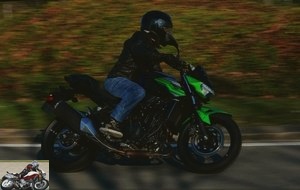 Kawasaki Z400 on departmental
Kawasaki Z400 on departmental
On departmental
Light, as we have said. A pleasant driving position, as has been said. An engine that operates over a wide rev range, as has been said. The Z400 is a little squaring the circle and it works, even more for young people allowed. You feel good and confident on the bike for all the aspects already mentioned and as the engine is not explosive either, you do not have the impression of having to constantly dose to get by. And then, this cycle part … lightly pressing on the front, the front axle is very precise and contributes to this overall confidence building. Even the arsouilles are possible, even if it is then necessary to seek the best in the turns, without ever any particular elastic effect and which can be destabilizing for the young driver..
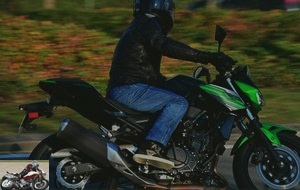 Motorway test
Motorway test
Comfort / Duo
Kawasaki is a sporty brand, a rule that historically determines the comfort of the brand’s machines, with little difference between the Ninja and the Z400. It’s pretty firm. And when the road is a bit bumpy, we jump a little in the saddle. Counterpart of this firmness, the bike remains a rail when the road deteriorates including when you are on the corner.
For the duo, no, the machine is not really made for the duo, or then requires a big dose of love! In fact, the position identical to that of the Ninja is that of a sportswoman. The passenger is perched high, so much so that it is necessary to use the footrests to climb behind. Advantage, the view of the passenger is then breathtaking and he would almost forget that he is sitting on a jump seat.
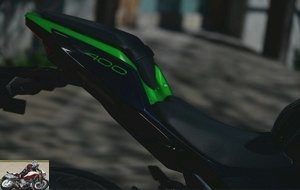 Saddle а 785 mm
Saddle а 785 mm
Braking
With a huge 310mm disc up front, it looks like it brakes very hard, like a sports car. But there are only two pistons. Suddenly, it brakes, but we do not do trapper braking with it. In fact, it is consistent with the power of the machine, no more and no less. It’s effective but without excessive bite, despite a pretty good feeling. In short, it is the ideal braking for an A2 license, so as not to surprise him and thus avoid putting too much power in the rain in particular. In any case, the ABS takes care of the grain and relatively sensitive to the rear, only asking to start on a support of the rear brake.
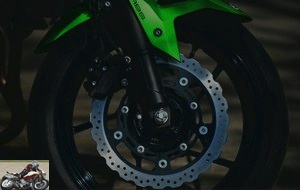 Single 310 mm petal disc. Caliper with double parallel pistons. ABS Nissin
Single 310 mm petal disc. Caliper with double parallel pistons. ABS Nissin
Consumption
The Z400 is capable of instantaneous consumption of going below 2 liters per hundred. And even at a stabilized speed of 90 km / h, its consumption stabilizes at 4 liters per hundred, which can be its consumption if you drive cool. But it still encourages you to play a little bit with the selector to extract the substantive marrow. And if the meter displays a proud 358 km of autonomy shortly after filling it, we will rather be around 300 km of autonomy with the 14-liter tank and a consumption closer to 4.7 liters in a slightly muscular drive and 4.5. in dynamic city driving. So, we put the machine in reserve at 245 km.
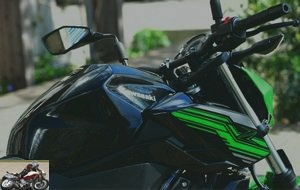 14 liter tank and consumption between 4 and 5 liters / 100 km
14 liter tank and consumption between 4 and 5 liters / 100 km
Convenient
If motorcycles of this displacement were practical, it would be known. We are no exception to the rule here, but we will still manage to accommodate a small disk unit under the saddle, or even the compulsory vest. But when both are inserted, the saddle will bulge out anyway.
On the other hand, there are pretty hooks on the sides, very practical for stowing a bag on the end of the saddle..
Conclusion
The Kawasaki Z400 is an excellent machine, ideal for a young license, or even a takeover of the motorcycle for an old license. Light, balanced, efficient, easy, it will also delight women of small stature who do not want to be afraid but who feel the energy greater than a 400 without wanting a machine that is certainly more powerful but also heavier, especially in low speed maneuvers. At 5,599 euros, the Z400 is 1,500 euros cheaper than the brand’s 650 and just 200 euros more than a CB300 but with much better fishing. And she has enough to accompany the biker for at least two years, if not more.
Strong points
- engine (availability range)
- box
- braking
- train before
Weak points
- comfort
Kawasaki Z400 technical sheet
Test conditions
- Itinerary: small varied roads + interurban highways with a bit of town
- Motorcycle mileage: 300 km
Kawasaki Z400 video test
Related articles
-
Evolution or revolution of the ER6-f with the in-line twin of 649 cm3, 68 horsepower for 193 kilos A more sporty look but, paradoxically, a gain in…
-
Honda CRF 250 L motorcycle test
A little trail that sparkles The great Escape You don’t like small cars? So be sure to read this article! Because after discovering this new Honda, you…
-
A new little sports car accessible to A2 licenses Twin cylinder in-line, 399 cm3, 45 hp at 10,000 rpm, 38 Nm at 8,000 rpm, 168 kilos, from € 5,999…
-
40 horses at 11,500 rpm 25.7 Nm, 175 kilos with full tank, two colors, € 5,799 An easy and sparkling little trail: what if life on a motorcycle was as…
-
Ninja Apprentice On paper, we imagine that the Kawasaki Ninja 250 R, with only 33 horsepower, will only appeal to the young drivers. After a week of…
-
Aprilia RS 660 motorcycle test
Root of RSV4 = RS 660 Parallel twin, 659 cm3, 100 hp, 67 Nm, 183 kg, A2 version, APRC pack, 11,050 euros Sportiness is the emblem of the Aprilia firm,…
-
Honda NC 700 S motorcycle test
Crisis solution Honda revives the basic motorcycle with its NC 700 S: a floor price, practical aspects borrowed from the scooter and consumption at the…
-
BMW GS 1250 motorcycle test daily
Flat Twin ShiftCam of 1,254 cm3, 136 hp and 143 Nm, 249 kg full made, from 17,599 euros Daily test for 15 days Already more than 800,000 big GS sold in…
-
4 cylinders in line, 948 cm3, 111 hp at 8,500 rpm, 10 m / kg at 6,500 rpm, 215 kilos, from € 11,999 A skillfully modified Z 900 or the worthy heir to the…
-
Indian 1200 FTR Rally motorcycle test
Bite V-Twin, 1203 cm3, 120 hp, 120 Nm at 6,000 rpm, 235 kg TPF, 14,990 euros … daily test The word scrambler warms up lots of images, broadcast, told,…
I just tried it this afternoon, I appreciated the evolution of the engine compared to my 2008 GS, the machine is sharp, precise, of exemplary stability, the saddle is comfortable, with a decent windshield of this name (not the bm) and the adapted luggage, we can see ourselves traveling with. On the other hand I do not agree with you at all on your appreciation of the suspensions, on degraded pavement the rear is sorely lacking in flexibility, yet in the "comfort" position, jumps and manhandles the lower back. It does not affect handling in any way, but really spoils the fun. Too bad it won’t be my next bike.
Hmmm … it’s still a roadster and the travel of your GS may have accustomed you to more progressiveness.
Anyway, and for its segment, the setting already seems comfortable. But there is also a part of personal feeling in the notion of comfort…
Why not an excellent 1200 RT ?
must see. I have 2 VFR 800 today, one for work, on my box for tax reasons (I am independent, and the IKs for big cubes are just shit up, it doesn’t even pay the full gasoline in the middle bracket) and one for the personal. The second has a good package of terminals and is at the end of its life with some problems whose repair would have a disproportionate cost compared to its value, which is the pure reason why I bought a second in OCCAZ at 80,000 km ago. year for my job because I made a lot of journeys between Paris and the provinces. Since then I moved to PR and I ride every day with the VFR pro which costs me dearly in gasoline, which is unnecessarily powerful for the short trips that I do now, and whose weight I begin to feel with age and joint problems after years of driving more than 200 on the motorway (piss off the well-meaning, by the way) or making long trips crossing the Dfrance by the departmentalsn (90 when possible). As for the second, I no longer use the masses, I work a lot and I do not have too much time to go on a trip and it is stiffer to drive with the age of the cycle part. In short, suddenly I tell myself that I could de-bone the old one and sell it piece by piece (if I can’t find anyone to take it back given its km and its worries), sell me the pro to have a machine with good road capabilities for when I would find the time to go on vacation, and take something light and economical for home / work round trips. Less gasoline costs, less physiotherapy costs
But I still find it difficult to take the step because of the price of these small machines. If we reduce the cost to the CV, it is still overpriced.